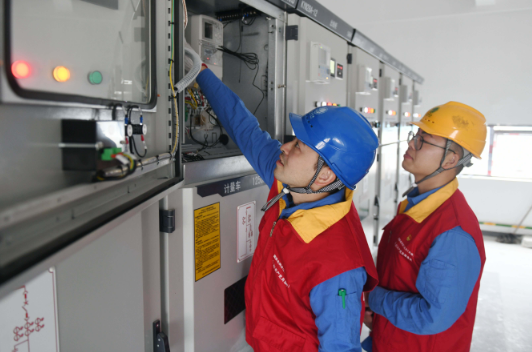摘 要
传统的定期检修与事后检修模式,随着我国智能电网的日渐普及已不能满足对电力系统供电可靠性的保障,因此逐渐转向更为经济可靠的状态检修。电力设备状态评估作为状态检修的前提,是电网工作人员制定检修策略极重要的参考。作为电力系统的末端系统,配电网及其设备的健康状况得到了广泛关注。配电设备健康不仅与自身绝缘老化相关,还.
与工作环境和运行条件密不可分。然而,以往对配电设备状态评估通常以设备历史统计的故障次数或配电设备状态评价导则来人为的评判设备健康程度,无法体现设备当前的真实状态,亦难以制定经济合理的检修措施。本文引入健康指数(HI) 作为评估配电设备健康状态优劣的指标,用以表征设备真实的健康状态。
首先,介绍了常见的设备故障率随运行时间的变化关系,以三种分布模型的P-P图为依据,选取威布尔分布作为设备故障率计算模型。同时引入役龄回退理论,阐述了检修对设备故障率的影响,并以变压器的故障实例数据进行威布尔分布参数的估算,建立基于威布尔分布的故障率计算模型。
其次,通过分析影响实际配电设备健康状况优劣的多种因素,运用层次分析法(AHP)给予各因素合理的权重:基于设备故障率和健康指数的映射关系,综合考虑主要配电设备的投运时间、在运状态、工作环境等因素建立了故障率修正模型;参照电力设备健康指数与故障率之间的函数关系,构建了考虑多因素的配电设备健康指数评估模型,并通过实例分析了实际配电网中关键设备的健康状况,给出了设备的健康指数。结果表明,本文提出的配电设备状态评估模型,在评估设备健康状态时,结果直观,有利于检修策略的灵活制定。
最后,以设备健康指数为基础,运用网络等值法和成功流法建立了配电网健康指数模型,分析了处于系统不同层次等级的设备健康指数变化对配电网健康状况的影响。
关键词 : 设备状态评估:健康指数(HI);层次分析法(AHP);实时故障率;役龄回退。
Abstract
With the expansion of the scale of smart grids and the continuous improvement of powersupply reliability requirements, the maintenance mode has gradually changed from regularmaintenance and after-sales maintenance to state-of-the-art maintenance. The conditionassessment of equipment is the prerequisite for state-of the-art maintenance and is an importantreference for formulating maintenance strategies. As the terminal system of the power system,the health of the distribution network and its equipment has received extensive attention. Thehealth of power distribution equipment is not only rclated to its own insulation aging. but alsoinseparable from its working environment and operating conditions. However, in the pastresearch on the status evaluation of power distribution equipment, the health of the equipmentwas artificially evaluated based on the number of failures counted in the history of theequipment or the evaluation guidelines for the status of the distribution network equipment,which could not reflct the current true state of the equipment, that is, it was difficult toformulate economics reasonable maintenance measures. This paper introduces the health index(HD) as an index to evaluate the health status of the main equipment in the distribution networkto characterize the true health status of the equipment.
Firsly, he iclationship betwccn the common equipment failure rate and the running timeand the graph are introduced. Based on the P-P diagram of the three distribution models, theWeibull distribution model is selected as the equipment failure rate calculation model. At thesame time, the service age regression theory is introduced, and the influence of maintenance onequipment failure rate is explained. And focus on the estimation of Weibull distributionparameters based on the fault instance data of the transformer, and establish the calculationmodel of the transformer failure rate based on Weibull.

Secondly, by analyzing the various factors that afeet the health status of the actual powerdistribution equipment, the Analytic Hierarchy Process (AHP) method is used to give eachfactor a reasonable weight; based on the mapping relationship between the equipment failure rate and the health index, comprehensive consideration of the main power distributionequipment A failure rate correction model was established for factors such as operating time,operating status, and working environment; referring to the functional relationship between thepower equipment health index and the failure rate, a power distribution equipment health indexevaluation model considering multiple factors was constructed, and an example was adopted.
The health status of key equipment in the actual distribution network is analyzed, and the healthindex of the equipment is given. The results show that the power distribution equipment stateevaluation model proposed in this paper has intuitive results when evaluating the health state ofthe equipment, which is conducive to the flexible formulation of maintenance strategies.
Finally, based on the equipment health index, the network equivalence method and thesuccess flow method are used to establish a distribution network health index model, and theimpact of changes in the equipment health index at different levels of the system on the healthof the distribution network is analyzed.
Key words : Equipment status assessment; Analytic Hierarchy Process (AHP); real-time failure rate;health index (HI); service age regression 。
1、绪论
1.1、研究背景与意义。
随着我国电网的快速发展,许多关键技术都面临着前所未有的挑战。从输电过程来看,我国电网大致可分为发电、输电和配电系统三部分。在发电和输电侧采用了多源供电、多回路输电的方式,以保证较高的可靠性,且关键的发、输电设备大都应用在线监测、定期离线试验等监控方式,严格保证设备安全可靠运行,并采取了多种维护手段,减少了因系统停运造成的损失[2]。配电网作为智能电网建设的重要环节,承担着直接与终端用户、分布式电源、电动汽车等间歇性负荷相承接的责任,但因其运行条件复杂,设备水平错落不齐,网络结构复杂,无法形成类似发、输电系统的可靠结构。研究表明,超过85%的电力故障发生在配电网侧[3]。因此,对配电设备和配电网健康状况进行健康状态评估,不仅有助于提高电力系统日常管理的效率,而且有助于智能电网的建设和现代配电技术的应用。
英国电网科研人员将电网设备运行状况与人体健康进行比较,利用人体健康指数(Health Index,HI)的相关理论识,类比电气设备劣化规律,提出了电气设备健康指数的概念[4]。这一概念主要针对电力系统中存在的大量如变压器、隔离开关、电缆等超期服役设备,恐因其超期服役而增加电网的故障率,破坏系统供电可靠性,对用户产生不良影响,故需以之为基础制定更为可靠的电网设备检修计划。随后,供电可靠性、资产管理等诸多领域的研究中都引入了这一概念[5-6],这有助于电网的风险控制,避免设备盲目维护、检修过剩等缺陷。在一定程度上降低运行维护成本,优化资源配置,提高了电力系统运行的安全性和供电可靠性。
目前,我国虽然开展了配电设备健康状况评价的相关研究,但国内的研究大多集中在高压变压器[7-9]。目前,配电设备健康评估不仅缺乏系统的理论和工具,而且其研究还未从设备层面延伸到网络层面。目前的评价模型和评价指标都比较简单,大多来自于现场经验,支持配电系统健康理论的数据平台亦尚未开发。
同时,配电网是一个实时动态系统,设备的健康状况取决于其运行状况,并受外部环境变化和自身需求的影响。因此,如何评价大量配电设备和复杂实时动态配电网的健康状况,不仅是现代电网发展中的一个新课题,也是现代智能电网发展进程中所面临的巨大挑战[10-11]。
【由于本篇文章为硕士论文,如需全文请点击底部下载全文链接】
1.2、配电设备状态评估的研究现状.
1.2.1、 国外研究现状
1.2.2 、国内研究现状
1.3、检修策略的研究现状.
1.4、主要研究内容
2、配电系统状态评估理论.
2.1、引言
2.2、健康指数理论
2.2.1、设备健康指数与状态的关系,
2.2.2、设备健康指数与检修方式的关系
2.2.3、设备健康指数与故障率的关系.
2.3、配电设备故障率
2.3.1、引言
2.3.2 、电气设备老化、劣化过程
2.3.3、元件故障率曲线
2.4、状态评估方法.
2.4.1、层次分析法,
2.4.2、模糊综合评判法
2.4.3、熵值法.
2.4.4、德尔菲法
2.5、配电系统可靠性指标
2.5.1、负荷点可靠性指标
2.5.2、系统可靠性指标
2.6、本章小结
3、配电设备故障率模型
3.1、设备故障率曲线
3.2、设备故障率分布函数
3.3、威布尔分布的参数计算
3.4、改进的役龄回退模型
3.5、算例分析.
3.5.1、变压器故障率分析.
3.5.2、故障率分布函数的确定
3.5.3、威布尔分布参数估算
3.5.4、役龄回退模型分析.
3.6、本章小结.
4、配电设备健康状态综合评估.
4.1、影响配电设备故障因素
4.1.1、设备故障因素
4.1.2、层次分析法确定故障因素权重.
4.2、配电设备故障率修正模型.
4.3、设备健康指数模型的建立
4.3.1、设备实时健康指数的计算.
4.3.2、设备健康指数的预测
4.3.3、算例分析.
4.5、配电网络健康状态评估.
4.5.1、网络等值法
4.5.2、成功流法(GO法)
4.5.3、评估流程.
4.5.4、算例分析.
4.6、本章小结.
5、总结
随着智能电网的日渐普及,准确评估配网设备健康状况,合理安排设备维修计划,防止发生大范围停电,有效预防偶然事故,延长设备生命周期是当前需要紧急解决的问题。
(1)由于配网设备数量繁杂、涉及面广、造价较低,则若采用输电网设备的评估方式来评估配网设备,不仅性价比低且多不适配。故而,本文从配网系统中变压器、断路器、隔离开关、架空线路和电缆线路等五类关键设备入手,主要介绍了设备健康指数和故障率相关的理论,阐述了健康指数与故障率的关系,建立了详细的配网设备健康指数的等级划分标准,并与设备状态的相对应。
(2)由于配电设备健康不仅与自身绝缘老化相关,还与其工作环境和运行条件密不可分。然而,在以往的配电设备状态评估研究中,通常以设备历史统计的故障次数或配网设备状态评价导则来人为的评判设备健康程度,无法体现设备当前的真实状态。故而,本文通过统计历史设备故障率,并利用P-P图法分析其全生命周期内分布情况,选取符合设备故障率变化趋势的威布尔分布函数作为描述配电设备故障率的模型。以58台故障变压器的统计数据进行算例分析,运用IBM SPSS 25软件拟合威布尔分布函数中的各参数,计算方法更为简单,得出的故障率更具客观性。
(3)综合考虑不同检修方案下对设备故障率的影响,引入役龄回退理论,更准确地确定设备故障率分布规律。针对影响设备故障因素,如负载率、大风大雨、高温、雷击气象等因素,利用影响设备故障因素和修正系数矩阵对威布尔模型中得出的设备故障率进行修正,得到符合在运设备真实状况的故障率。其次,基于健康指数和故障率的映射关系给出设备健康指数的计算公式,通过实例分析了实际配电网中关键设备的健康状况,结果表明,本文提出的配电设备状态评估模型,评估设备的健康状态,结果直观,有利于配电公司检修策略的灵活制定。
(4)最后,以计算得到的设备健康指数为基础,运用网络等值法和成功流法建立了配电网健康指数模型,分析了不同层次等级的设备健康指数变化对网络健康状态的影响,可知网络中层次等级越高的设备,其健康指数变化对整体网络的健康状况影响越大。
参考文献
[1] 敖蕾蕾,王慧芳,张弛,李- -泉,何奔腾.基于D-S证据理论的输变电设备状态检修多目标群决策[J].电网技术,2014,38(06): 1627-1633.
[2]陈安伟. 输变电设备状态检修的应用[J]电网技术,2009,3(20):215-218.
[3] 刘健,张小庆,张志华。继电保护配合提高配电自动化故障处理性能[J].电力系统保护与控制,2015,43(22):10-16.
[4] Barnfather P, Hughes D, Wells R. Condition -based ri sk management of physical assets within the electrical power sector[C]IET & IAM Asset Management C onference 201 2,2012:1-5.
[5] 秦继承,吴娟.基于电网状态评估的风险防范管理体系应用研究[J].中国电力,2007(04):90-92.
[6]基于电网状态评估的风险防范管理体系研究[J].云南电业,2007(08):38.
[7]廖瑞金,黄飞龙杨丽君,郑含博,巩晶.变压器状态评估指标权重计算的未确知有理数法[J].高电压技术,2010,36(09):221 9-2224.
[8]谭贵生,曹生现,赵波,魏宏建,刘丹丹.基于关联规则与变权重系数的变压器状态综合评估方法[J].电力系统保护与控制,2020,48(01):88-95.
[9]、卞建鹏,杨苏,高世闯,滑伟静.基于全寿命周期成本的电力变压器检修决策[J].电力系统及其自动化学报,2019,31(05):77-83.
[10]张钧,何正友,谭熙静.- 种基于ANFIS的配电网故障分类方法及其适应性分析[J]电力系统保护与控制,2011,39(04):23-29.
[11] 张姝,谭熙静,何正友,臧天磊,赵静.基于层次分析法的复杂配电网健康诊断研究[J].电力系统保护与控制,2013,41(13):7-13.
[12] Hughes D, Dennis G, Walker J, et al. Condition BasedRisk Management(CB RM)- Enabling Asset Condition Information to be Central to Corporate Decision Making[]. Engineeri ng Asset M anagement, 2008:1212-1217.
[13] Hughes D, Pears T, Tian Y. Linking engineering knowledge and practical experience to investment planning by means of condition based risk management [C]. Condi tion Moni tori ng and Diagnosis, CMD 2008. Internati onal C onference on IEEE, 2008: 539-542.
[14] Hughes D, Pschierer-Barnfather P, Pears T. Condition based risk management (CB RM): bringing excellence in asset management into the boardroom[C]. Electricity Distribution-Part 1, 2009. C IRED 2009. 20th Internati onal Conference and Exhi bition on. IET, 2009: 1-4.
[l5] 马钊,周莉梅,盛万兴.国际资产管理标准ISO 55000与PAS 55的分析与比较[J].供用电,2015,32(06):48-53+59.
[16]周莉梅,马钊,盛万兴,现代配电网健康指数理论最新研究进展[J].供用电,2016,33(01):3-7+13.
[17] 鞠平,左英飞,文福拴,卫志农,马宏忠,电力系统健康诊断[J].电力自动化设备,2004(06):22-25.
[18] 苏鹏声,王欢。电力系统设备状态监测与故障诊断技术分析[J].电力系统自动化,2003(01):61-65 +82.
[19]张爽,田浩,焦龙,李旭涛,周莉梅,李毅强.基于役龄回退理论的电网设备健康指数建模方法[].供用电,2016,33(01):8-13.
[20]余柳玉,袁海文,马钊,周莉梅.中低压配电设备状态信息采集系统总体设计及其实现中的关键软硬件技术[J].供用电,2016,33(01 ):21-24+13.
[21] 马钊,周莉梅,袁海文,施慎行,刘颖异,尚宇炜,盛万兴,苏剑.现代配电网健康指数理论及其应用研究[J]中国电机工程学报,2019,39(01):130-140+328.
[22]李毅强,董清,程林,马钊,周莉梅.一种辐射型配电系统的网络健康性能评价方法[J].现代电力,201 6,33(05 ):68-73.
[23] 王荣.基于设备健康指数的配电网络状态评价方法的研究[D].西安理工大学,2019.
[24]张楠,袁海文,马钊,周莉梅.基于层次分析结构的配电变压器健康指数评价方法[J].供用电,2016,33(01):14-20.
[25] Tang W H,Spurgeon K,Wu Q H,et al.An evidential reasoning approach to transformer condition accessments[J]IEEE Transactions on Power Delivery,2004, 19(4):1 696-1703.
[26] 朱承治,郭创新,孙旻,等.基于改进证据理论的变压器状态评估研究[J]高电压技术,2008,34(11):2332-2337.
[27] Wu L,Zhu Y,Li X,et al.Applicati on of multiagent and data mining techniques in condition assessment of transformers[C ].Internati onal Conference on Power System Technology,2004,1:823-827





